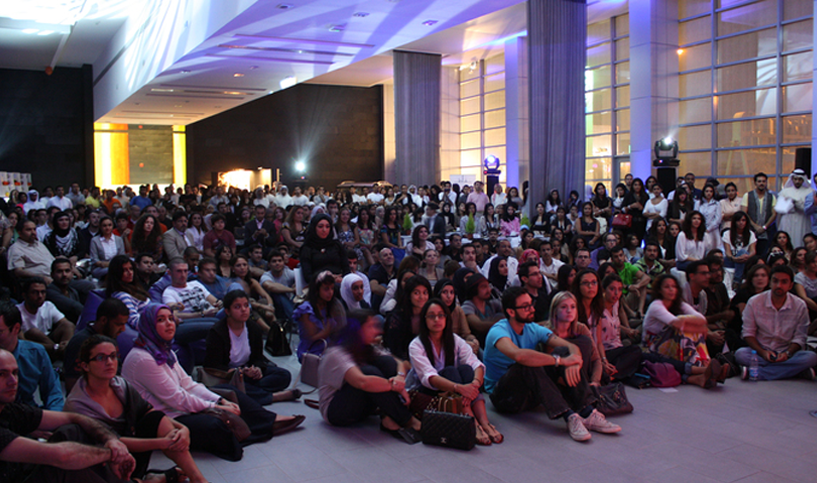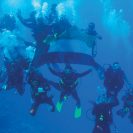By Nada Faris
Everybody was wondering when and where they might have been able to use their expensive coats and pullovers that were gathering dust in their closets. The day they should have done so was the fourteenth of January. The avenue was the back garden of the Scientific Center where the merciless sea breeze threatened even the most obstinate of noses. Mine ran faster than Rabaa Al-Hajri in a triathlon!
I shouldn’t really complain about the weather because the organizers had warned people about it prior to the show. Anyone who registered in their Facebook group received an email asking people to dress warmly. It also included another warning: The seating as usual will be limited; however there is plenty of space on the grass. I turned around halfway through the show and found, to my surprise, a great number of people just standing! I cannot imagine how they must have felt, standing for hours in the biting weather. So I decided to take space from this article to congratulate them. Rather than just going back home, or hitting one of the million burger joints in Kuwait, they stayed to support the presenters. That, I believe is admirable.
As usual, Pecha Kucha included a variety, not only of different types of speakers, but also of quality. Roa Al-Shaheen, an architecture student at Kuwait University, went first. Roa’s project was to distinguish between perceived reality and actual reality. She spoke eloquently. Her organization of slides was logical and included the following examples: Reality TV, Virtual Reality Medications, Fake Diamonds, Facebook, Fake architecture, and logos that follow the gestalt theory. Even her conclusion was fitting. Roa ended with: “This is it, I shall leave you to determine if I really gave a presentation, or if you only perceived me giving one.” Is the concept new though? I am not referring to an academic milieu (where Jean Baudrillard’s notion of simulacra and simulation play a fundamental role in understanding our contemporary world). Rather, I am talking about previous Pecha Kucha presentations that already discuss this notion of perceived reality in opposition to actual reality. Roa salved her genuine effort by discussing her designs. She created interactive furniture and pixilated shadow graffiti that really separated her from the crowd.
Reham Al-Sharif went next with a presentation titled: The Alien. She explained that it was born out of a questioning of norms and commenced with segregation. When she found it really strange that males and females park on different levels in Kuwait (who knew?), she expanded her enquiry to concepts such as beauty, discipline, fashion, time, love, death and faith. With an unusual hairstyle, Reham told the audience that it was because she was an alien that she was able to see all of the things that we have been conditioned to take for granted. Unfortunately, as an alien, she moralized frequently. For instance, Reham (or the alien) broached the concept of beauty. And according to her, God never created anything that was ugly, so one should not change one’s features. Moreover, faith for this alien resides in the heart, and cannot be found in mosques, churches and temples. Another example of heinous moralizing is when she portrayed an image of a black veil with silver embroidery and declared that this is not the “right” image of a veil. It is this kind of blanket moralizing that makes norms seem natural in the first place.
Valerie Buchheit told us, like all the architects who participated in PKN, that “design is a tool for change.” However, unlike others, she didn’t only theorize the possibility of design; rather, she showcased tangible examples of her accomplishments. Valerie had traveled from New York City, where she had been working day and night, to Tanzania and then to Kuwait. This cross continental journey culminated in 2007 in Africa, where she had been asked to oversee the construction of a healing compound. It was there that they discovered a brick-making method in an environmentally friendly manner that avoids deforestation. Valerie assured the audience that her time in Africa was also characterized by periods of fun and entertainment. And the reason she came to Kuwait was to give a voice to people who might not have one, and to get involved with non-profit projects. Before ending her presentation, Valerie encouraged her audience to mingle and to get to know one another.
I enjoyed Barrack Al-Babtain’s “Urban Density,” because it intended an immediate improvement of Kuwait’s public spaces. Rather than building more isolated shopping malls, Barrack urges his audience to plant trees. According to his equation, more trees lead to more shade, which leads to more people walking on the streets of Kuwait. Hence, Barrack concludes, to safer streets. The problem is that Kuwait is currently dependant on cars. And this mentality creates isolated public spaces that will reinforce this mentality—in a vicious and endless cycle. Barrack also stated that a Kuwait metro might help break this cycle because it will induce more people to walk. His ending was great: “The best time to plant trees was twenty years ago…the second best time is today.”
Zed Alrefai was a charismatic whirlwind. His “Electric City,” included images of his mountain-climbing trips. Zed said that he had been climbing for twenty years and almost died in 2001 where a grave was dug and prepared for him. He made light of the matter by saying that “Life is not fair.” He followed that by informing us of his statuses. Zed is the first Arab to climb Mount Everest back when the success rate was only 20% and the 46th climber in the world to reach the summit of all major mountains. He also gladly told us that his best friend was a bottle of oxygen.
Alia Al-Ghunaim succeeded Zed, and she discussed “Bayt Abdulla.” Alia explained that seven years ago the mission began as a thesis project inspired by Abdulla, a little boy who came back from London and wanted to live in peace, away from hospitals and sickbeds. Thus, rather than creating a hospital for dying patients, Alia created a resort without the wards and hospital rooms. The resort includes a Gym, a theater, a school, mosques, and shops, to help dying patients live to the fullest. Everything was professional until the end of her presentation where she decided to show an “inspirational” clip, which wasn’t inspirational at all. The clip portrayed computer generated graphic close-ups tinted with shadow and angle-lighting of the said resort, which she could have made without.
Next came Rabaa Al-Hajri and Ahmed Al-Majed who discussed the sport of the triathlon. Although their presentation was in lecture form—they defined the sport, offered a brief history, and explained the various types and requirements—their relaxed and charming demeanor appealed to the audience. The end, is only the beginning for these athletes and they concluded by encouraging others to participate in their 3 Club.
Maryam Al-Hamad was the last presenter. She discussed a project that she had been working on for Loyac since 2006. This project’s aim is to educate people around the world, because “education is not preparation for life, but life itself.” Maryam depicted the way that her team has continually traveled back to Kenya to build more classrooms, supply chairs, blackboards, computer labs and tables, as well as to build a kitchen. For more information on this project visit: http://k4k.loyac.org .
It is regrettable to state that this Pecha Kucha’s audience was even quieter than the preceding one. No one asked questions (presumably since everyone was freezing) and Dr. Asseel Al-Ragam quickly thanked everyone for coming and reminded them that there will be three more nights scheduled throughout 2010. Pecha Kucha Night invites all sorts of people with creative visions and critical thoughts. If you think you might be one of them, why don’t you try out for the next one?
For more information about the author, please visit www.nadafaris.com.








